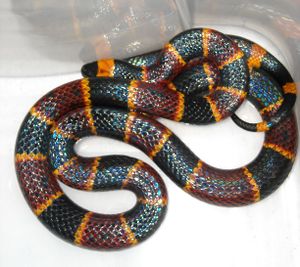Snake bites: Difference between revisions
No edit summary |
No edit summary |
||
| Line 1: | Line 1: | ||
== | ==Background== | ||
*In the United States, snake bites can be organized into [[Crotaline (Pit Vipers)]] and [[Elapidae (Coral Snakes)]] | *In the United States, snake bites can be organized into [[Crotaline (Pit Vipers)]] and [[Elapidae (Coral Snakes)]] | ||
*Crotalidae family also includes rattlesnakes, Sistrurus and Agkistrodon species (water moccasins and copperheads).<ref>Goldfranks Toxicology - Envenomations</ref> | *Crotalidae family also includes rattlesnakes, Sistrurus and Agkistrodon species (water moccasins and copperheads).<ref>Goldfranks Toxicology - Envenomations</ref> | ||
==Clinical Features== | |||
==Differential Diagnosis== | ==Differential Diagnosis== | ||
Revision as of 22:45, 2 July 2015
Background
- In the United States, snake bites can be organized into Crotaline (Pit Vipers) and Elapidae (Coral Snakes)
- Crotalidae family also includes rattlesnakes, Sistrurus and Agkistrodon species (water moccasins and copperheads).[1]
Clinical Features
Differential Diagnosis
Envenomations, bites and stings
- Hymenoptera stings (bees, wasps, ants)
- Mammalian bites
- Closed fist infection (Fight bite)
- Dog bite
- Marine toxins and envenomations
- Toxins (ciguatera, neurotoxic shellfish poisoning, paralytic shellfish poisoning, scombroid, tetrodotoxin
- Stingers (stingray injury)
- Venomous fish (catfish, zebrafish, scorpion fish, stonefish, cone shells, lionfish, sea urchins)
- Nematocysts (coral reef, fire coral, box jellyfish, sea wasp, portuguese man-of-war, sea anemones)
- Phylum porifera (sponges)
- Bites (alligator/crocodile, octopus, shark)
- Scorpion envenomation
- Reptile envenomation
- Spider bites
Diagnosis
- Clinical Diagnosis
Treatment
Disposition
See Also
References
- ↑ Goldfranks Toxicology - Envenomations




